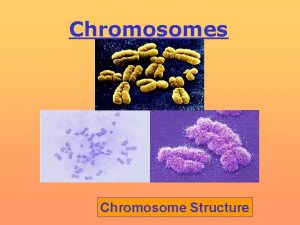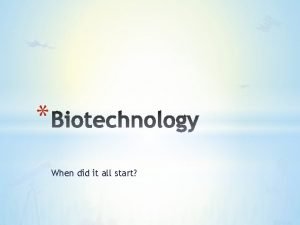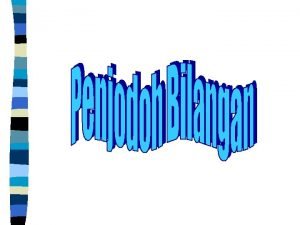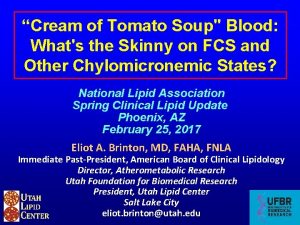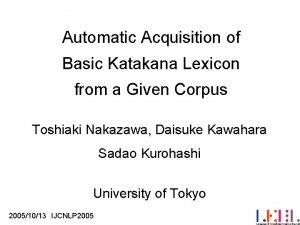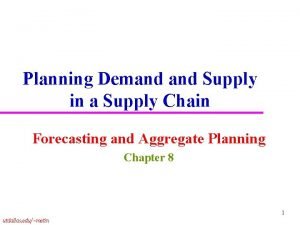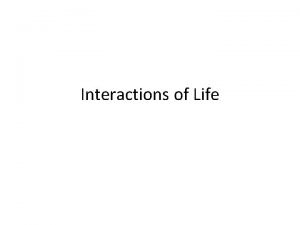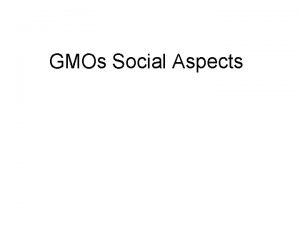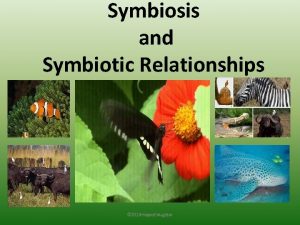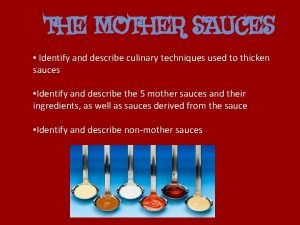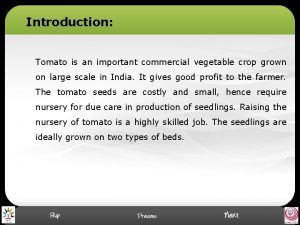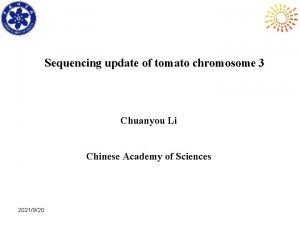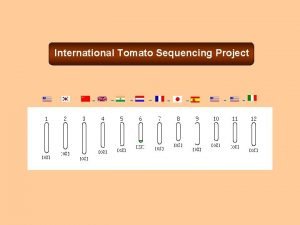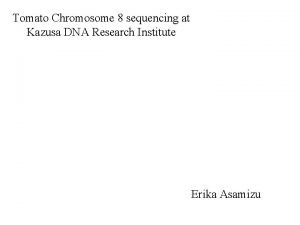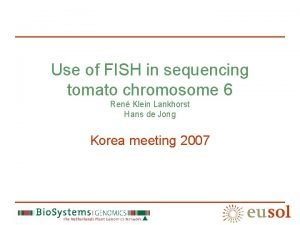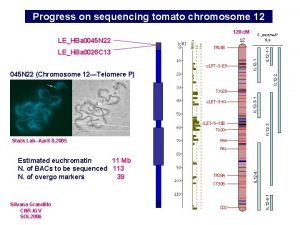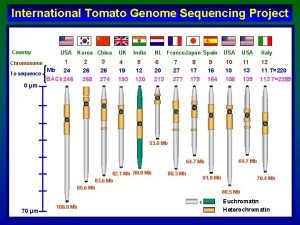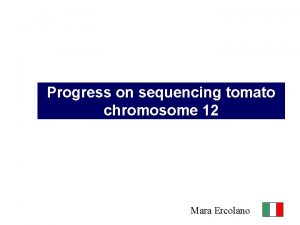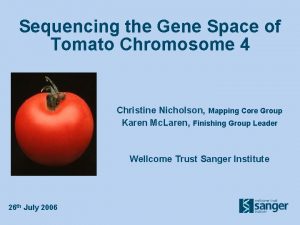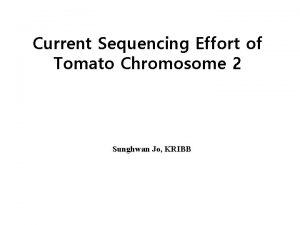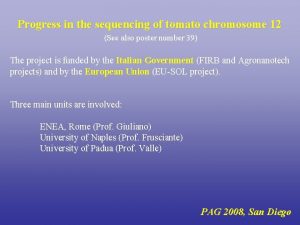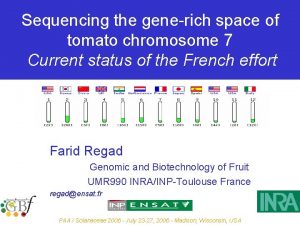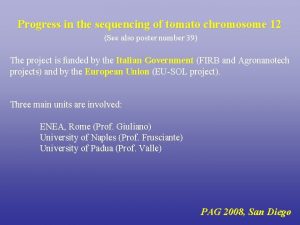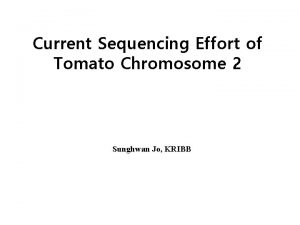Tomato Chromosome 4 A Mapping Sequencing Update Christine

















- Slides: 17

Tomato Chromosome 4: A Mapping & Sequencing Update Christine Nicholson Mapping Core Group Welcome Trust Sanger Institute, UK 28 th September 2005

FPC Database • Mapping strategy = to develop the physical map in order to select minimal tiling paths across the chromosome to sequence, in conjunction with BES data and markers. • FPC database worked on in-house at Sanger • Obtained from Arizona Genomics Institute • The FPC Database: – – – LE_HBa library fingerprints 88, 584 fingerprinted BACs (68% of total library) Possibly due to contamination of library Therefore, Have ~ 10 X coverage in the fingerprint map.

Libraries No. of clones Average insert size **No. of Coverage in genome fingerprints equivalents BES available Mated Pairs % LE_HBa* 129, 024 117 kb 15 X 10 X 152, 819 68 SL_Mbo. I 52, 992 135 kb ~7 X - 101, 755 70 SL_Eco. RI 72, 264 95 -100 kb ~7 X - 99, 455 65 * Heinz 1706 **Based on genome size of 950 Mb.

Chromosome 4 Contigs • Examined seed BACs/contigs for each chromosome using overgo probes. (Conducted by Cornell) ftp: //ftp. sgn. cornell. edu/tomato_genome/seedbacs/20050112_chr 4_long_short. xls • 54 markers on chromosome 4 in the current FPC build • Each potential chromosome 4 contig assessed in silico in FPC: - structure based on fingerprints - marker content – assigned to how many contigs? - possible merges to other contigs? September 2005: 58 contigs currently on chr 4

Pilot Sequencing • • • Select 5 BACs to form “pilot sequencing”. In two different regions of the chromosome Tomato BACs are being processed through our sequencing pipeline. • Apply our Finishing programmes to tomato clones & examine sequence features e. g. repeats. Sequencing Pipeline at WTSI……

Sequencing Pipeline At Wellcome Trust Sanger Institute: Mapping • Single colonies • Clone verification (PCR using BES probes) Subcloning Production (Shotgun sequencing) Finishing QC Further digest check MIPS (automated) ANNOTATION Imperial College manual annotation

Wellcome Trust Sanger Institute Sequencing MJs: Cycle sequencing Packard Minitrak: Sequencing reactions set-up ABI 3730 s: Sequence data generated & analysed

Sequencing Pipeline At Wellcome Trust Sanger Institute: Mapping • Single colonies • Clone verification (PCR using BES probes) Subcloning Production (Shotgun sequencing) Finishing QC Further digest check MIPS (automated) ANNOTATION Imperial College manual annotation

Selected Chromosome 4 BACs Stage Selected for Sequencing Finishing No. of BACs 3 2 • Located in contig 270 • Marker C 2_At 5 g 37360 • LE_HBa clones: 198 L 24 (contains marker) 31 HO 5

Sequence data available for 2 BACs Clone Accession No. of gaps contigs Approx. size 13 H 05 CT 025877 3 2 (All spanned) 168 kb 198 L 24 CT 025873 7 6 165. 5 kb (5 spanned) ftp: //ftp. sanger. ac. uk/pub/sequences/tomato/unfinished_sequence/

Finishing - Analysis in GAP 4 • • • PHRED – calls bases PHRAP – assembly GAP 4 – view & edit

FISH Analysis • BAC 198 L 24 underwent metaphase FISH. • Confirmed chr 4. • Reported to be in heterochromatic region. • However, no major issues (repeats etc. ) in Finishing Image courtesy of S. B. Chang, Prof S. Stack’s Laboratory, University of Colorado, USA.

Genes in Sequenced BACs? • Used WUBLASTX align proteins against the tomato sequence. • Partial gene highlighted in each BAC 31 H 05 putative carboxyl-terminal peptidase 198 L 24 AMT 1. 2 Ammonium transporter 1 member 2

Mapping Strategy * AIM = Reduce the current contig number * WHY? • Select longer minimal tilepaths across the chromosome • Smaller overlaps of selected sequence BACs (aim for 1520 kb) • More efficient sequencing HOW? • Work on FPC database to improve continuity • Walk off sequenced clones (once available) using BES hits • Incorporate further BES/fingerprint data as generated • Possible walk from contig ends by hybridization.

Further Map Development & Fingerprinting? • Have been able to replicate the fingerprinting technique from AGI. • 31 H 05 and 198 L 24 fingerprints confirmed. • Will use this for future clone verification. • Currently have 10 X coverage in fingerprints. • Investigating the practicalities and possibilities of augmenting the fingerprint database → SL_Mbo. I library?

Further BAC Selection Strategy • Intend to select minimal tilepaths to sequence ideally over reduced number of contigs on chromosome 4. • Will FISH more BACs across the chromosome obtain confirmation of chromosome location of BACs & contigs they are contained within.

Acknowledgements Wellcome Trust Sanger Institute: Jane Rogers Sean Humphray Carol Scott Karen Barlow Helen Beasley Sarah Sims Jennifer Harrow Carol Carder Paul Hunt Mark Maddison Imperial College London: Gerard Bishop University of Warwick: Graham Seymour FUNDING Cornell University: Lukas Mueller Arizona Genomics Institute: Rod Wing Seunghee Lee Colorado State University: Stephen Stack Song-Bin Chang Scottish Crop Research Institute: Glenn Bryan
 Prokaryotic chromosome vs eukaryotic chromosome structure
Prokaryotic chromosome vs eukaryotic chromosome structure Shadow paging recovery technique
Shadow paging recovery technique Memory parameters
Memory parameters Forward mapping vs backward mapping
Forward mapping vs backward mapping Transform mapping dan transaction mapping
Transform mapping dan transaction mapping Flavr savr tomato
Flavr savr tomato Sejambak kunci
Sejambak kunci Is a candle living or nonliving
Is a candle living or nonliving Hdl tomato soup
Hdl tomato soup Lebensversicherungsgesellschaftsangestellter
Lebensversicherungsgesellschaftsangestellter Red tomato tools case study
Red tomato tools case study Tss of heavy tomato puree
Tss of heavy tomato puree Parasitism examples
Parasitism examples Flight planning for aerial photography
Flight planning for aerial photography Calgene flavr savr tomato
Calgene flavr savr tomato Parasitism
Parasitism Ratio for roux
Ratio for roux Introduction of tomato
Introduction of tomato
